You’ve heard it everywhere: you need to make coffee bloom. The only response when you’re a beginner to coffee is a confused look to these kinds of statements, but we’re here to clear things up for you!
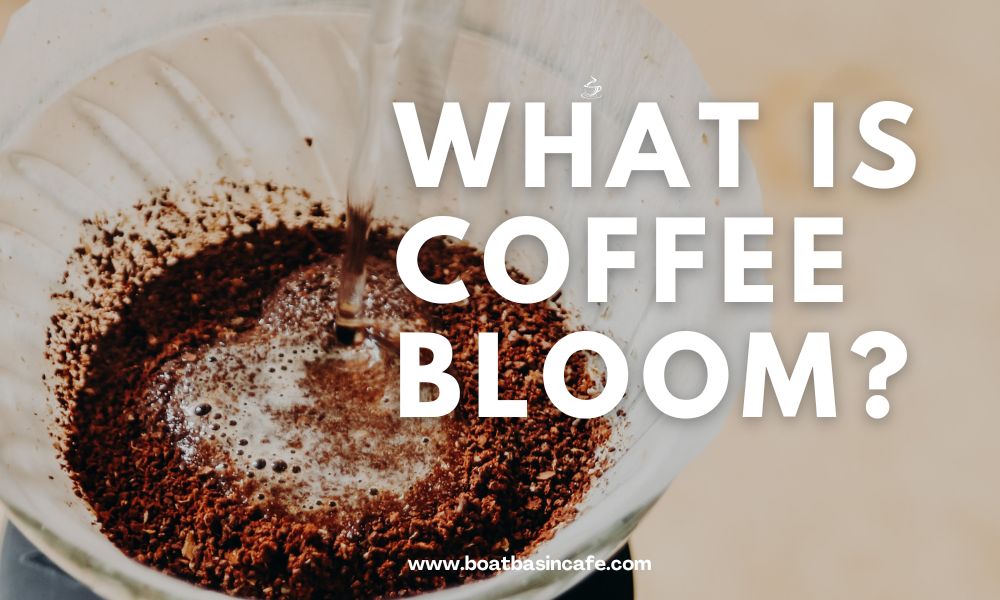
For everything about coffee bloom, how to do it, and why it should be done, read our article below:
What Is Coffee Bloom?
If you see foaming and bubbling in the surface area of your coffee during the brewing process, you’re watching coffee bloom. Nope, the bubbles aren’t just there without a name — it’s actually an important part of your coffee-brewing process!
Blooming coffee is also called pre-infusion by many coffee drinkers.
History of Coffee Blooming
Coffee was first found in the highlands of Ethiopia, where it was used for thousands of years by nomadic tribes. Coffee was used in Yemen monasteries to help people stay awake so they could pray. I guess it’s just the way people are that they find studying boring.
By the 16th century, trade routes through the Mediterranean brought it to Europe and the Middle East, but only the wealthy could get it, and it wasn’t popular in Europe until the 17th century, when coffee houses opened. The Dutch brought coffee to America in the end.
Today, it’s one of the drinks that millions of people all over the world drink the most. Some people can’t start their day until they’ve had a cup of coffee.
What Makes Coffee Bloom? The Science Behind It
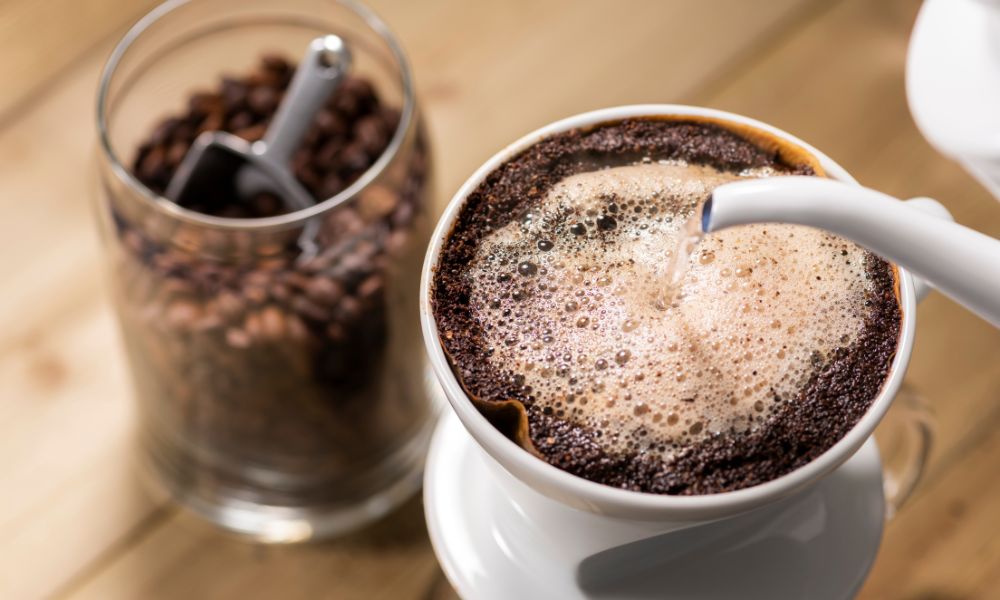
But what does make coffee bloom like this?
The answer is simple. Coffee bloom is really just the coffee releasing carbon dioxide when the coffee comes into contact with water. Fresh coffee grounds then bubble and expand.
The mystery behind the coffee bloom is also straightforward.
Coffee, once roasted, begins a degassing process. It gives off carbon dioxide over fourteen days or two weeks.
However, the most gas is released during the first few hours of the roasting process, then over the next week. Apart from naturally degassing, grinding your coffee also releases carbon dioxide.
The grinding increases the coffee’s surface area, which increases the amount of gas each coffee bean releases.
When ground coffee comes into contact with hot water, the degassing process is sped up even more. This is what causes the coffee bloom in the first place!
Why Should I Bloom Coffee? Benefits of Coffee Blooming
Okay, so you know what a coffee bloom is, and how it happens. But what’s the point of blooming coffee anyway? Can’t you just drink freshly roasted coffee as it is without the coffee blooming process?
You could do so, but you’ll be missing out on the benefits that blooming coffee gives:
Improved Taste
Believe us: carbon dioxide does not taste good. And if you don’t bloom your coffee, the carbon dioxide in the coffee beans will be infused into the taste of the coffee itself.
Carbon dioxide tastes sour, sure, but it also does more of a disservice to your freshly ground coffee. This is because carbon dioxide repels water. As a result, the water won’t be able to start extracting flavor from freshly roasted beans!
Better extraction
Blooming causes the coffee grinds to expand and become more porous, allowing for greater flavour and fragrance extraction.
Consistency
Blooming may assist to make a more uniform cup of coffee by ensuring that all of the grounds are wetted equally.
Increased Scent:
The release of carbon dioxide during flowering may also improve the aroma of the coffee, providing a more pleasing sensory experience.
Better crema
Blooming may also aid in the improvement of crema, the froth that develops on the surface of espresso shots.
Reduced Bitterness
Blooming may assist to lessen bitterness in the cup by allowing for improved extraction, resulting in a smoother, more balanced coffee.
So, let coffee bloom! Let the carbon dioxide escape and you won’t have a sour taste in your coffee. You’ll have all the flavor compounds you could want with all the natural gases and other volatile compounds out of the way.
How to Bloom Coffee? What Equipment Required? 4 Different Brewing Methods
With different brewing methods, it may be hard to know how to bloom coffee properly. Whether you’re using a coffee maker or a French press, we have you covered:
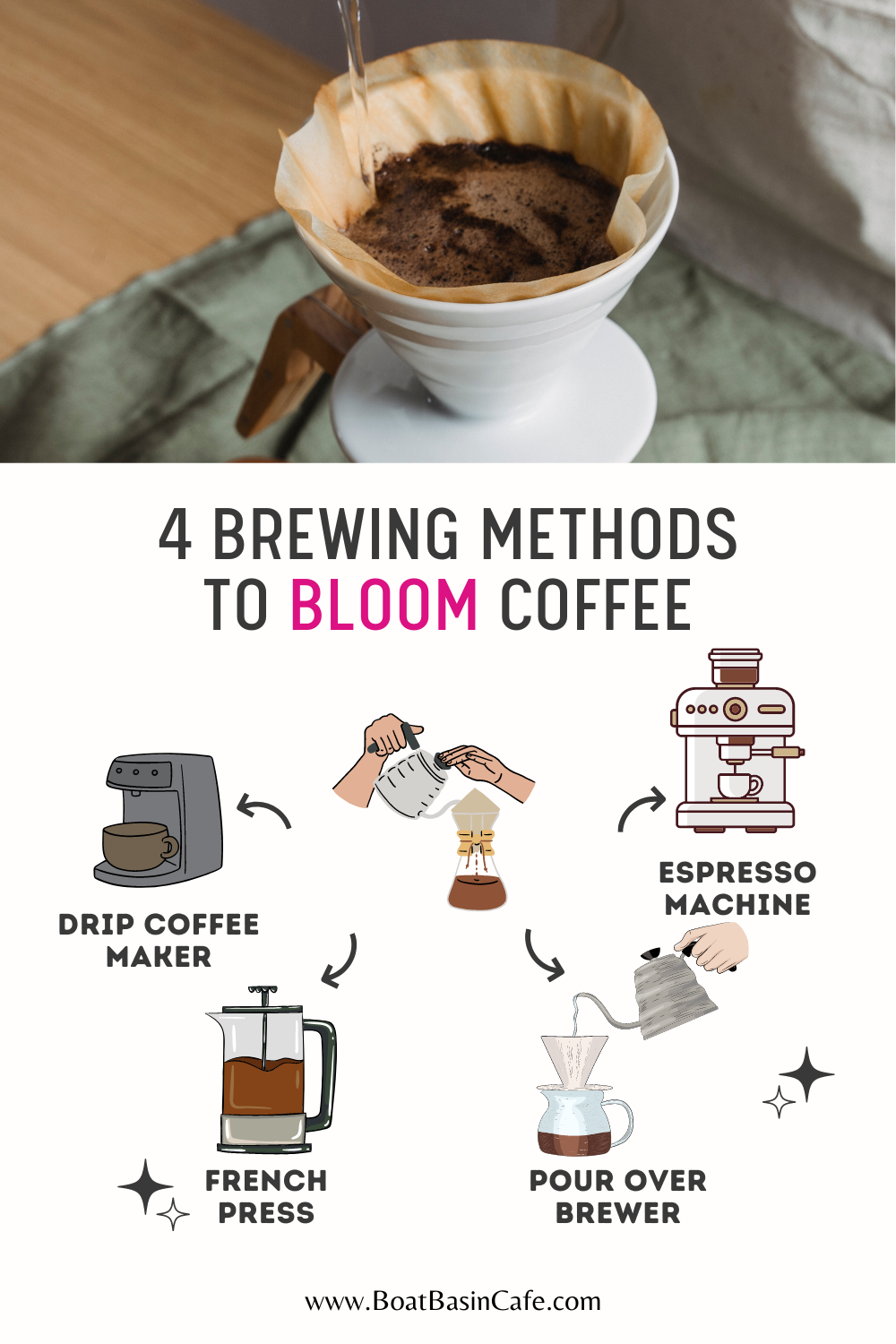
With a French Press
It helps to start the bloom process with a timer ready. You can either have a dedicated kitchen timer or simply use your phone for tracking how long you bloom freshly roasted coffee for.
Boil some water first. You want your ground coffee to be as fresh as possible, so it helps if you’re grinding your very own coffee beans.
Place your ground coffee beans at the very bottom of the French press. Now, it’s time to bloom!
Set a timer to at least four minutes. Prepare your hot water. Pour the hot water onto the coffee grounds — just enough to have them all uniformly soaked. Once the hot water hits the coffee, the beans degas!
Slowly pour hot water in a circular motion until the coffee grounds are dripping wet. Let it soak for a while. Once the timer has 30 seconds left on it, pour the remaining water into the French press to steep it for around five minutes. Then, you can press the plunger down to separate the grounds. You’ve got good coffee in such a short time!
With Automatic Drip Coffee Makers
Is it possible to bloom coffee grounds in your automatic drip coffee maker? Every local coffee shop and coffee enthusiast seems to think so! All you have to do is follow our steps.
Use a paper filter for the drip basket. Make sure you’re not using an absorbent coffee filter — you don’t want the flavor compounds from the ground beans to be absorbed, and as a result, lessening the rich flavor profile of your coffee. Instead, we recommend using a Gold Tone Coffee Filter like this.
Add your ground coffee to the paper filter. Let the filter basket fill up halfway as you pour in hot water. It helps if you stir the coffee grounds for a little before letting the coffee bloom on its own.
Around 60 seconds should be enough for blooming your coffee. After this brewing method, you can go ahead and start on your coffee brewing routine. Go to your regular brew cycle and start it up!
With Pour-Over Coffee
With pour-over coffee, brewing coffee — and blooming it — has never been easier! The concept of blooming coffee comes from the pour-over method anyway. All you have to do is put down a paper filter into your cup and measure out the coffee grounds.
Measure out the amount of hot water you’re going to use next. For pour-over coffee, we recommend coffee blooming and brewing with a gooseneck kettle. We recommend this electric gooseneck kettle from COSORI! The shape of the spout allows for a more even blooming and brewing phase.
Pour over the hot water over the grounds to allow the coffee to bloom.
With an Espresso Machine
Remember how we mentioned coffee blooming your coffee bed is also known as pre-infusion? That applies to blooming with an espresso machine! In fact, the crema we all know and love with espresso is because of coffee bloom — it’s all sealed in, where gas can’t escape.
With pre-infusion, you soak the puck of your ground coffee gently in hot water. Make sure that water evenly penetrates all the coffee grounds for an even extraction!
How to Ensure a Bloom
Want to know how you can achieve a coffee bloom? Maybe you’ve always been curious — or you actually want it to be a vital step in the brewing and roasting process. See how you can ensure a bloom below:
#1 Make Sure the Coffee is Fresh
A coffee bloom only happens with fresh beans and coffee grinds. How much gas coffee ends up releasing depends on the freshness of the coffee itself. So, if you’ve already roasted and ground your coffee for a while, it might not bloom at all. The organic material and volatile compounds have already been released!
#2 Store Your Coffee Properly
Have you already roasted and ground your coffee, but you still want coffee to bloom? Freshness will depend on how you store your coffee then!
Before we get into storage, make sure you maximize whatever freshness you get first. Use whole beans fresh from coffee harvests, and grind your own beans. To get the most out of your coffee, we recommend drinking a cup of coffee within a month that you get coffee roasted.
Now, let’s get into storage. Let’s start with the basics: use an opaque, air-tight container. Keeping your coffee beans away from light and air is key to fresh coffee!
You also shouldn’t store each coffee bean for too long. Even if you put your coffee in all the right containers possible, it’s going to get stale and carbon dioxide will be released the longer it’s kept.
Heat should also be looked out for. High temperatures will degas your coffee, releasing the more gas or carbon dioxide in each bean. Cold temperatures will slow down the aging of your coffee instead!
Don’t, however, make the mistake of putting your coffee in the fridge. The fridge has a lot of odors and moisture that will age your coffee further. So, if you love coffee, simply put it in a cool, dry place instead!
If you don’t have an airtight container, a vacuum-sealed bag should do the trick. Happy storing!
#3 Look Into Your Brewing Temperature
Coffee blooms will occur at higher temperatures, which are generally around 92 and 96 degrees Celsius. If you have any device at all that can gauge the temperature of your water, you can make sure you have the right brewing temperature to get coffee blooms.
#4 Check The Roast Degree
In general, we have three roast degrees: light, medium, and dark. As less time is involved in roasting light coffee, it won’t release carbon dioxide the way dark roasts will. There’s less gas and oils trapped in a light roast compared to other roasts that underwent a longer roasting process.
This doesn’t mean, however, that darker Italian roasts, for example, will stay fresher for longer. It just means that they’ve trapped more carbon dioxide and oils into the coffees grown. As much as possible, proper roasting, grinding, and storage should still apply!
#5 Look at the Grind Particle Size
There’s some science involved in the coffee bloom process! Due to the gases exposed and displaced by the water, you might see more of a bloom with finely ground beans instead of coarsely ground coffee. If blooming doesn’t happen right away, you might have had too coarse of a grind.
What If I Don’t See a Bloom?
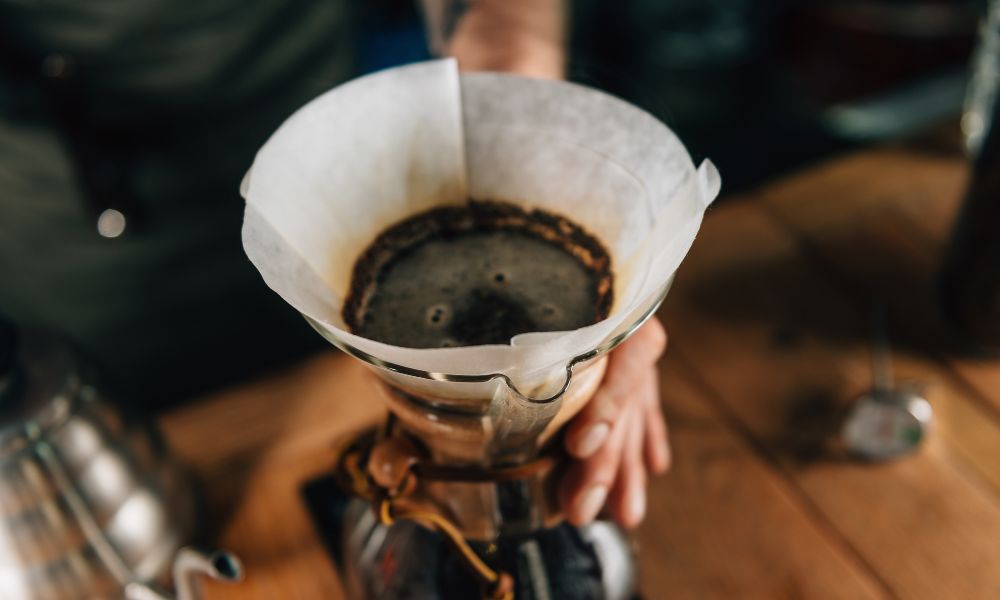
Not seeing a bloom is mainly a sign that your coffee is no longer as fresh as you thought! It could also mean something regarding your brewing temperature and grind particle size, as we mentioned above.
How to Make a Cold Brew with Coffee Bloom
#1 Grind Your Coffee
Use freshly ground coffee for your cold brew! For cold brew coffee, you’d want a coarse grind.
#2 Start with the Bloom
Bloom the coffee by wetting it evenly with water. Bloom time around 30 to 60 seconds.
#3 Combine Coffee and Water
Start by putting the grounds into the container you’ve dedicated for the cold brew. Add water and combine by stirring gently!
#4 Steep Overnight
Cover your container with a lid or plate to keep it safe from dust and bugs. You can steep your coffee for 12 hours or longer. You can leave it out on the kitchen table or counter, or refrigerate it while it steeps.
#5 Strain
Prepare some cheesecloth or flour sack cloth. Use a large measuring cup or bowl and line it with the cheesecloth or flour sack. Pour the coffee from the jar and through the strainer.
#6 Store or Serve
Transfer the coffee to another bottle or jar. You can store it for a week or serve it with ice and milk! Congratulations, you’ve made your very own cold brew!
How to Make Turkish Coffee with Coffee Bloom
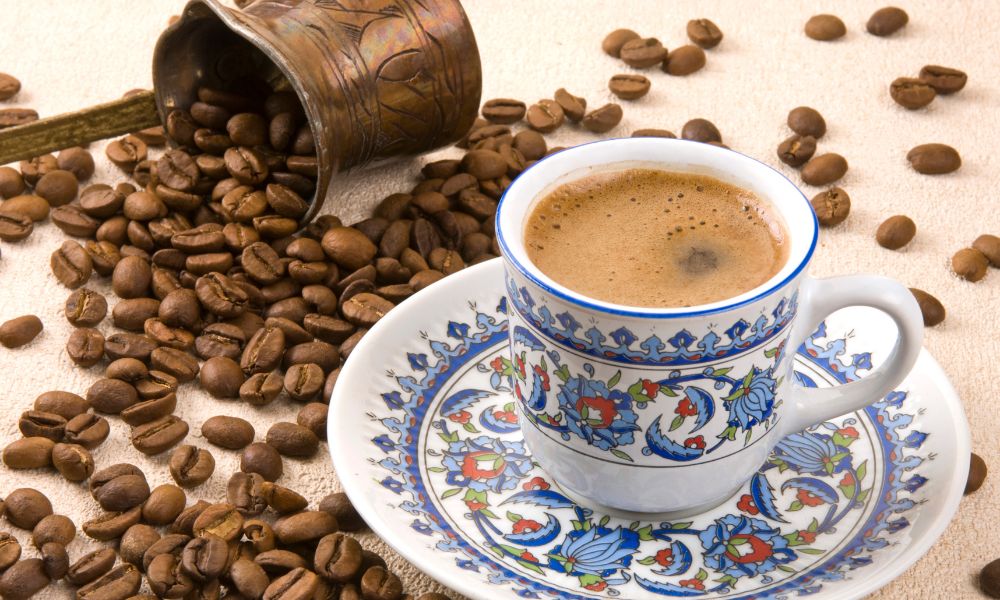
#1 Use Turkish Coffee and a Turkish Pot
Buy some Turkish coffee and a pot to go with this recipe. It’s essential to the success of your Turkish coffee!
#2 Combine Sugar, Water, and Coffee Over Medium Heat
Wet coffee first to bloom it. Then, stir sugar, water, and coffee together in the pot. Put the pot on the stove-top on medium-heat and start boiling.
#3 Transfer Foam Build-Up
As you bring the mixture to a boil, dark foam will build up. Transfer this foam using a teaspoon to your coffee cups.
#4 Pour Boiled Coffee
Pour half of the coffee into the cups filled with foam. Return to the stovetop and let it boil again.
#6 Serve
Transfer the remaining coffee into the cups. Congratulations, you’ve made Turkish coffee!
How do I Avoid Under-Extracted Coffee?
Aside from a sour taste that not having a bloom gives, under-extracted coffee will give the same results. The solutions are quite simple! All you need to do is tweak the following:
#1 Water Temperature
Just use hotter water! Many coffee brews won’t extract its flavors with colder water. Don’t use cool or lukewarm water — but be careful not to use too hot water either. The tradeoff is burnt, bitter coffee if you do so!
#2 Brewing Time
Extraction is all about how long your water has interacted with coffee, so your brewing time is important. This is a common mistake with pour-over coffee and the French press! You should let the coffee steep for longer to be able to extract all the flavor possible from the coffee.
#3 Coffee Grind
You can experiment with different grinds to see which is the better choice for your brewing method, but if you want more flavor, you should grind your coffee finer. There’s more area for the water to extract flavors from!
Frequently Asked Questions:
What is the bloom in coffee?
The bloom in coffee is the release of gases — like carbon dioxide — from each coffee bean. While the bloom might not be apparent with a coffee maker or other brewing methods, it’s obvious when you make fresh roasted coffee with a pour-over or drip coffee maker.
The “bloom” looks like a bunch of bubbles and froth coming up to the surface of your cup of coffee.
How long should I bloom my coffee?
Ideally, it should be no longer than 30 to 60 seconds. If you’re using a French press or pour-over, you can time it!
Do you need to bloom coffee?
Not necessarily! But when you do bloom coffee, you allow more flavor and depth to come out, no matter the bean hardness. When the gases aren’t released from each coffee bean, you’re left with coffee with a sour taste.